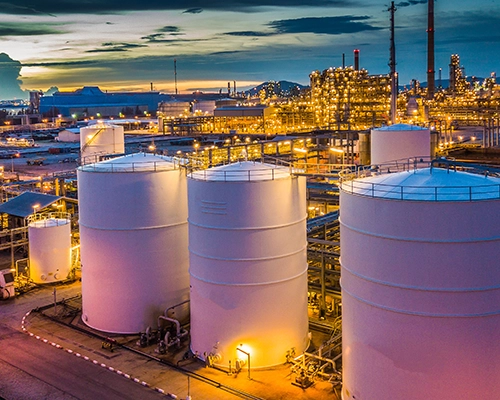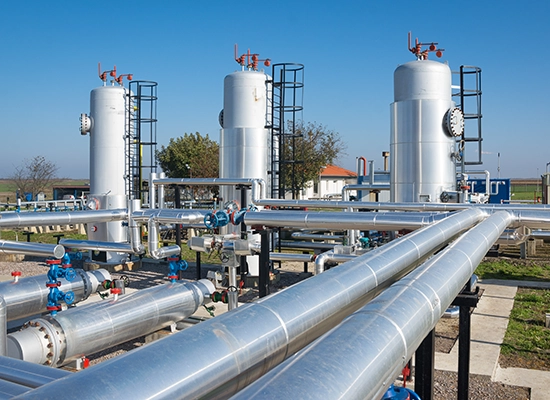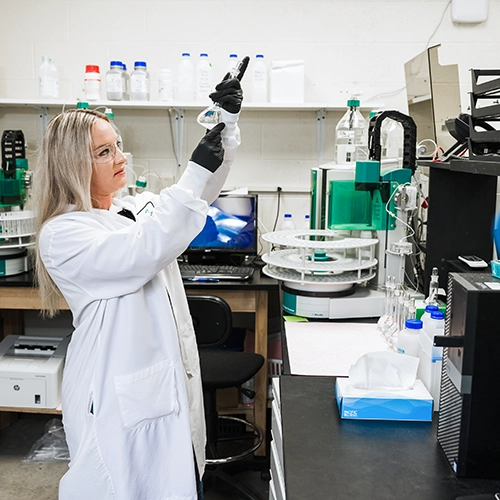Petroleum Contamination In Soil
Petroleum contamination can be a significant health and environmental hazard. Gasoline, diesel, oil, and other petroleum products can seep into the local environment through leaks, spills, or improper disposal. These contaminants can degrade soil quality, negatively impacting plant growth and reducing the soil’s ability to support microbial life. Additionally, petroleum compounds can leach into groundwater, polluting drinking water sources and threatening aquatic habitats.
Testing soil for petroleum contaminants allows for early detection and remediation, safeguarding the well-being of individuals, communities, and the environment. Soil testing can also help delineate the extent of the contamination and identify other impacted matrices, such as groundwater and surface water. Pace offers a wide range of testing services for petroleum contaminants in soil and sediment.
Who We Serve
Many environmental projects include testing soil for petroleum contamination to assess the impact of industrial activity on the local environment and provide data-driven recommendations for remediation and prevention strategies.
Soil analysis is an essential tool in the oil and gas industry for detecting and quantifying petroleum contaminants in the soil. By analyzing soil samples, industry professionals can identify the presence of hydrocarbons, heavy metals, and other pollutants that pose risks to human health and the environment.
Refineries and petrochemical plants must ensure the safety of their operations and maintain regulatory compliance. Regular environmental testing helps identify potential leaks or spills, enabling prompt remediation and minimizing the environmental impact and potential health hazards associated with contaminated soil.
Transportation and bulk storage facilities frequently test the soil surrounding their facilities to detect potential leaks or spills from tanks and pipelines, to ensure the integrity of their infrastructure and minimize environmental, health, and litigation risks.
Analyzing soil for petroleum contamination is a crucial step in assessing the integrity of aboveground and underground storage tanks (UST). By detecting the presence of contaminants, such as gasoline and diesel fuel, in the surrounding soil, retail operators can identify potential leaks or breaches in their storage systems. This analysis allows them to take timely corrective action to prevent further environmental damage and potential regulatory penalties.
Municipalities have a responsibility to safeguard their citizens, which often includes monitoring industrial activity and its impact on the local community and environment. By proactively testing for petroleum contamination, municipalities can mitigate potential environmental damage, safeguard public health, and uphold their commitment to responsible land management practices.
By proactively testing soil for petroleum contaminants, businesses demonstrate their commitment to environmental stewardship and regulatory compliance. Additionally, monitoring local soil quality can help avoid potential legal liabilities and fines associated with non-compliance while also protecting the facility's reputation and maintaining public trust.
Analyzing Petroleum Contaminants In Soil For Regulatory Compliance
In the United States, federal regulations such as the Comprehensive Environmental Response, Compensation, and Liability Act (CERCLA) and the Resource Conservation and Recovery Act (RCRA) govern the assessment, management, and remediation of contaminated sites. These regulations, enforced by the Environmental Protection Agency (EPA), establish guidelines for identifying and addressing soil contamination caused by petroleum products. Additionally, state-level agencies may have their own regulations and standards, which may be more stringent than federal requirements.
Petroleum Contamination Special Projects
Pace® offers petroleum contamination testing to help consultants, engineers, and industries with a wide range of environmental testing needs.
Decommissioned MGPs pose significant technical and financial challenges to successor property owners, including municipalities and other public entities undertaking brownfields revitalization. Soil analysis helps identify the presence and concentration of petroleum contaminants as well as delineate the area of contamination to aid in the remediation of former MGP sites.
Soil analysis can help oil and gas pipeline operators detect potential leaks, assess the integrity of the pipeline, and evaluate the impact of soil properties on pipeline performance. With regular testing for petroleum contaminants in the soil around a pipeline, operators can proactively address potential issues and implement appropriate maintenance or repair measures to ensure the safe and efficient operation of the pipeline system.
Regular testing of soil for petroleum contaminants can help property owners monitor the integrity of their UST. By analyzing the soil surrounding USTs, operators can identify the presence of contaminants, such as petroleum hydrocarbons, which may indicate a leak or breach in the tank system. Regular soil analysis can also help in evaluating the effectiveness of leak detection systems and ensuring compliance with environmental regulations.
Environmental site assessments are frequently performed before a property is purchased, sold, or approved for a specific use, particularly when the site was part of the oil and gas supply chain, e.g. gas stations, transportation and storage facilities, refineries, etc. The data from the soil analysis helps property owners, buyers, and regulators evaluate the environmental risks associated with a property, make informed decisions about the property's value and suitability, and ensure compliance with environmental regulations.
In incidents such as pipeline ruptures, tanker truck accidents, train derailments, or storage tank leaks, soil analysis for petroleum contamination can provide valuable insights into the concentration and distribution of contaminants in the impacted area. By rapidly assessing the soil's contamination levels, emergency response teams can develop targeted and effective cleanup strategies, prioritize resources and efforts, and minimize the environmental and public health risks associated with the release of petroleum contaminants. Soil analysis is also used to monitor the progress and effectiveness of remediation efforts, reducing long-term environmental impacts and potential liability issues.

Petroleum Hydrocarbon Forensics
Petroleum hydrocarbon forensics uses advanced analytical techniques and methods to identify the source, age, and distribution of petroleum contaminants in soil. Petroleum hydrocarbon forensics can be useful in determining the source of contamination, as petroleum products are chemically complex and can be highly variable in composition.

TPH is used to quantify the concentration of petroleum-based hydrocarbon contaminants present in an environmental sample. In combination with other analytical techniques, TPH can contribute to the overall understanding of the contamination and support forensic investigations.
PHI is used to characterize petroleum-based hydrocarbon contaminants in environmental samples by providing detailed information on the composition, source, and age of the contaminants. Crucial for forensic analysis of environmental contamination, this information can help identify responsible parties, determine the extent of the contamination, and guide remediation efforts.
SHC is a specialized technique used to identify and quantify saturated hydrocarbon compounds, such as alkanes and cycloalkanes, in environmental samples. By providing detailed information on the composition and origin of these contaminants, SHC also aids in identifying responsible parties, assessing the extent of contamination, and guiding effective remediation strategies.
A common component of petroleum-based contamination, VOCs pose significant risks to human health and the environment. Due to their volatile nature, VOCs can migrate through soil and groundwater, leading to the contamination of air, drinking water, and entire ecosystems. Characterization of VOCs can help identify their source and guide remediation strategies.
PAHs are a class of organic compounds formed primarily through the incomplete combustion of fossil fuels and other organic materials. PAHs are known for their persistence and potential toxicity. Testing soil samples for PAHs is essential for environmental compliance and can help identify the source of the contaminants.
Geochemical Biomarker Analysis is used to identify and characterize specific organic compounds, or biomarkers, that provide valuable information about the source, age, and depositional environment of the organic material, including petroleum contaminants, in an environmental sample, such as soil.
Why Select Pace®
The largest American-owned environmental lab in North America, Pace® has a well-established reputation for delivering fast, reliable analytical services to a wide range of customers, including government agencies, industries, and environmental consultants. Pace® is NELAC and DOD certified, as well as certified in every state that offers a lab accreditation program.
By leveraging our expertise, advanced analytical techniques, and cutting-edge instrumentation, we ensure that the data generated is accurate, reliable, and defensible. Our comprehensive service offerings, including project planning, sampling, and data interpretation, make Pace® the go-to resource for clients seeking to comply with environmental regulations or assess and mitigate the impacts of petroleum contaminants on the environment and human health.

Additional Resources
-
Pace® Environmental Certifications
-
Pace® Environmental Emergency Response
-
Related Pages
-
Downloadable Resources
Need to find a lab that can handle your unique requirements?
Contact us directly or download our list of environmental certifications across our network.
When disaster strikes, the Pace® Environmental Emergency Response Team is here to help you act fast.